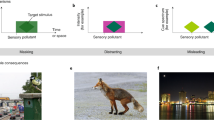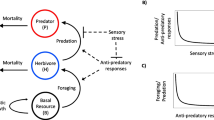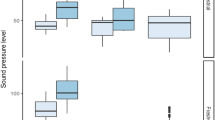Abstract
All organisms rely on sensory systems to obtain, interpret, and respond to information available in their environment. With rapid alterations of ecosystems occurring across the globe, organisms are being faced with sensory challenges that result in behavioural changes and disruptions with potential population-level consequences. Through a consideration of sensory ecology, it is possible to identify the underlying causes of disturbances at the individual level and use this information to develop better-informed, highly targeted, and more effective management strategies. Indeed, sensory-based approaches have already been successful in response to a variety of conservation issues. This article provides a general discussion of how a consideration of sensory ecology can benefit conservation biology and proceeds to describe three areas of rapid growth and potential for expansion: (1) mitigation of anthropogenic noise disturbance; (2) prevention and amelioration of ecological and other evolutionary traps; (3) targeted population control with special attention to aquatic invasive species. I conclude with general recommendations on how sensory ecologists and conservation biologists can mutually benefit from integrated endeavours.
Similar content being viewed by others
References
Ali MA (1978) Sensory ecology review and perspectives. Plenum, New York
Amorim MCP (1996) Sound production in the blue green damselfish Chromis viridis (Cuvier,1830) (Pomacentridae). Bioacoustics 6:265–272
Baker C, Hicks BJ (2003) Attraction of migratory inanga (Galaxias maculatus) and koaro (Galaxias brevipinnis) juveniles to adult galaxiid odours. N Z J Mar Freshw Res 37:291–299
Barber JR, Crooks KR, Fristrup KM (2010) The costs of chronic noise exposure for terrestrial organisms. Trends Ecol Evol 25:180–189
Barton DC, Holmes AL (2007) Off-highway vehicle trail impacts on breeding songbirds in northeastern California. J Wildl Manag 71:1617–1620
Battin J (2004) When good animals love bad habitats: ecological traps and the conservation of animal populations. Conserv Biol 18:1482–1491
Belanger RM, Smith CM, Corkum LD, Zielinski B (2003) Morphology and histochemistry of the peripheral olfactory organ in the round goby, Neogobius melanostomus (Teleostei: gobiidae). J Morphol 257:62–71
Bowdan E, Wyse GA (1996) Sensory ecology: introduction. Biol Bull 191:122–123
Buckstaff KC (2004) Effects of watercraft noise on the acoustic behavior of bottlenose dolphins, Tursiops truncatus, in Sarasota Bay, Florida. Mar Mammal Sci 20:709–725
Campbell-Palmer R, Rosell F (2011) The importance of chemical communication studies to mammalian conservation biology: a review. Biol Conserv 144:1919–1930
Caro T, Sherman PW (2011) Endangered species and a threatened discipline. Trends Ecol Evol 26:111–118
Carroll SP, Watters JW (2008) Driving phenotypic variability with genetic and environmental heterogeneity: adaptation as a first principle of conservation management. In: Carroll SP, Fox CW (eds) Conservation biology—evolution in action. Oxford University Press, Oxford, pp 181–198
Christy JH (1995) Mimicry, mate choice, and the sensory trap hypothesis. Am Nat 146:171–181
Clemmons JR, Buchholz R (1997) Linking conservation and behavior. In: Clemmons JR, Buchholz R (eds) Behavioral approaches to conservation in the wild. Cambridge University Press, Cambridge, pp 3–22
Corkum LD (2004) Pheromone signalling in conservation. Aquat Conserv 14:327–331
Crossland MR, Haramura T, Salim AA, Capon RJ, Shine R (2012) Exploiting intraspecific competitive mechanisms to control invasive cane toads (Rhinella marina). Proc R Soc B 279:3436–3442
Curio E (1996) Conservation needs ethology. Trends Ecol Evol 11:260–263
Dangles O, Irschick D, Chittka L, Casas J (2009) Variability in sensory ecology: expanding the bridge between physiology and evolutionary biology. Q Rev Biol 84:51–74
Dooling RJ, Popper AN (2007) The effects of highway noise on birds. Environmental bioacoustics LLC report for California Department of Transportation
Dooling RJ, Lohr B, Dent ML (2000) Hearing in birds and reptiles. In: Dooling RJ, Popper AN, Fay RR (eds) Comparative hearing: birds and reptiles. Springer, New York, pp 308–359
Dusenbery DB (1992) Sensory ecology: how organisms acquire and respond to information. W. H. Freeman, New York
Edwards DP, Yu DW (2007) The role of sensory traps in the origin, maintenance, and breakdown of mutualism. Behav Ecol Sociobiol 61:1321–1327
Eigenbrod F, Hecnar SJ, Fahrig L (2008) The relative effects of road traffic and forest cover on anuran populations. Biol Conserv 141:35–46
Endler JA, Basolo AL (1998) Sensory ecology, receiver biases and sexual selection. Trends Ecol Evol 13:415–420
Francis CD, Ortega CP, Cruz A (2009) Noise pollution changes avian communities and species interactions. Curr Biol 19:1415–1419
Gilroy JJ, Sutherland WJ (2007) Beyond ecological traps: perceptual errors and undervalued resources. Trends Ecol Evol 22:351–356
Great Lakes Fishery Commission (2010) Synthesized sex pheromones lure lampreys into traps. News release, August 10, 2010
Halfwerk W, Bot S, Buikx J, van der Velde M, Komdeur J, ten Cate C, Slabbekoorn H (2011a) Low frequency songs lose their potency in noise urban conditions. Proc Natl Acad Sci USA 108:14549–14554
Halfwerk W, Holleman LJM, Lessells CM, Slabbekoorn H (2011b) Negative impact of traffic noise on avian reproductive success. J Appl Ecol 48:210–219
Hebets EA, Papaj DR (2005) Complex signal function: developing a framework of testable hypotheses. Behav Ecol Sociobiol 57:197–214
Hedrick P (2001) Conservation genetics: where are we now? Trends Ecol Evol 16:629–636
Higgs DM (2005) Auditory cues as ecological signals for marine fishes. In: Weissberg MJ, Browman HI (Coords). Sensory biology: linking the internal and external ecologies of marine organisms. Mar Ecol Prog Ser 287:263–307
Horvath G, Blaho M, Egri A, Kriska G, Seres I, Robertson B (2010) Reducing the maladaptive attractiveness of solar panels to polarotactic insects. Conserv Biol 24:1644–1653
Imre I, Brown GE, Bergstedt RA, McDonald R (2010) Use of chemosensory cues as repellents for sea lamprey: potential directions for population management. J Gt Lakes Res 36:790–793
Johnson NS, Siefkes MJ, Li W (2005) Capture of ovulating female sea lampreys in traps baited with spermiating male sea lampreys. N Am J Fish Manag 25:67–72
Kasumyan AO (2009) Acoustic signaling in fish. Jpn J Ichthyol 49:963–1020
Klump GM (1996) Bird communication in a noisy world. In: Kroodsma DE, Kroodsma EH (eds) Ecology and evolution of acoustic communication in birds. Cornell University Press, New York, pp 321–328
Landa A, Tømmeras BA (1997) A test of aversion agents on wolverines. J Wildl Manag 6:510–516
Letcher BH, Priddy JA, Walters JR, Crowder LB (1998) An individual-based, spatially-explicit simulation model of the population dynamics of the endangered red-cockaded woodpecker, Picoides borealis. Biol Conserv 86:1–14
Li W, Scott AP, Siefkas MJ, Yan H, Liu Q, Yun SS, Gage DA (2002) Bile acid secreted by male sea lamprey that acts as sex pheromone. Science 296:138–141
Margles SW, Peterson RB, Ervin J, Kaplin BA (2010) Conservation without borders: building communication and action across disciplinary boundaries for effective conservation. Environ Manag 45:1–4
Martin GR (2011a) Through birds’ eyes: insights into avian sensory ecology. J Ornithol. doi:10.1007/s10336-011-0771-5
Martin GR (2011b) Understanding bird collisions with man-made objects: a sensory ecology approach. Ibis 153:239–254
McGregor P (2005) Animal communication networks. Cambridge University Press, New York
Myrberg AA Jr, Spires JY (1972) Sound discrimination by the bicolor damselfish, Eupomacentrus partitus. J Exp Biol 57:727–735
Parks SE, Clark CW (2007) Short- and long-term changes in right whale calling behavior: the potential effects of noise on acoustic communication. J Acoust Soc Am 122:3725–3731
Patricelli GL, Blickley JL (2006) Avian communication in urban noise: causes and consequences of vocal adjustment. Auk 123:639–649
Piersma T (2011) From spoonbill to Spoon-billed Sandpiper: the perceptual dimensions to the niche. Ibis 153:659–661
Popper AN, Hastings MC (2009) The effects of human-generated sound on fish. Int Zool 4:43–52
Rabin LA, McCowan B, Hooper SL, Owings DH (2003) Anthropogenic noise and its effect on animal communication: an interface between comparative psychology and conservation biology. Int J Comp Psychol 16:172–192
Rheindt FE (2003) The impact of roads on birds: does song frequency play a role in determining susceptibility to noise pollution? J Ornithol 144:295–306
Richardson WJ, Würsig B, Greene CR (1986) Reactions of bowhead whales, Balaena mysticetus, to seismic exploration in the Canadian Beaufort Sea. J Acoust Soc Am 79:1117–1128
Robertson BA, Hutto RL (2006) A framework for understanding ecological traps and an evaluation of existing evidence. Ecology 87:1075–1085
Rollo A, Higgs D (2008) Differential acoustic response specificity and directionality in the round goby, Neogobius melanostomus. Anim Behav 75:1903–1912
Rollo A, Andraso G, Janssen J, Higgs D (2007) Attraction and localization of round goby (Neogobius melanostomus) to conspecific calls. Behaviour 144:1–21
Rosell F, Czech A (2000) Responses of foraging Eurasian beavers Castor fiber to predator odours. Wildl Biol 6:13–21
Sawyer H, Nielson RM, Lindzey F, McDonald LL (2006) Winter habitat selection of mule deer before and during development of a natural gas field. J Wildl Manag 70:396–403
Schaub A, Ostwald J, Siemers BM (2008) Foraging bats avoid noise. J Exp Biol 211:3174–3180
Scheifele PM, Andrew S, Cooper RA, Darre M, Musiek FE, Max L (2005) Indication of a Lombard vocal response in the St. Lawrence River beluga. J Acoust Soc Am 117:1486–1492
Schlaepfer MA, Runge MC, Sherman PW (2002) Ecological and evolutionary traps. Trends Ecol Evol 117:474–480
Schmidt KA, Dall SRX, van Gils JA (2010) The ecology of information: an overview on the ecological significance of making informed decisions. Oikos 119:304–316
Siemers BM, Schaub A (2011) Hunting at the highway: traffic noise reduces foraging efficiency in acoustic predators. Proc R Soc B 278:1646–1652
Sih A, Ferrari MCO, Harris DJ (2011) Evolution and behavioural responses to human-induced rapid environmental change. Evol Appl 4:367–387
Slabbekoorn H, Ripmeester EAP (2008) Birdsong and anthropogenic noise: implications and applications for conservation. Mol Ecol 17:72–83
Sorensen PW, Stacey NE (2004) Brief review of fish pheromones and discussion of their possible uses in the control of non-indigenous teleost fishes. N Z J Mar Freshw Res 38:399–417
Sorensen PW, Vrieze LA (2003) The chemical ecology and potential application of the sea lamprey migratory pheromone. J Gt Lakes Res 29:66–84
Southwood A, Fritsches K, Brill R, Swimmer Y (2008) Sound, chemical, and light detection in sea turtles and pelagic fishes: sensory-based approaches to bycatch reduction in longline fisheries. End Sp Res 5:225–238
Stacey NE, Sorensen PW (2005) Hormones, pheromones, and reproductive behaviors. In: Sloman KA, Balshine S, Wilson RW (eds) Behaviour: interactions with fish physiology. Academic, New York, pp 359–412
Stalhandske P (2002) Nuptial gifts of male spiders function as sensory traps. Proc R Soc Lond B Biol 269:905–908
Stebbing PD, Watson GJ, Bentley MG, Fraser D, Jennings R, Rushton SP, Sibley PJ (2004) Evaluation of the capacity of pheromones for control of invasive non-native crayfish. English nature research reports no. 578, English Nature, Peterborough
Stockwell CA, Hendry AP, Kinnison MT (2003) Contemporary evolution meets conservation biology. Trends Ecol Evol 18:94–100
Stowers L, Marton TF (2005) What is a pheromone? Mammalian pheromones reconsidered. Neuron 46:699–702
Swaisgood RR (2010) The conservation-welfare nexus in reintroduction programmes: a role for sensory ecology. Anim Welf 19:125–137
ten Cate C, Rowe C (2007) Biases in signal evolution: learning makes a difference. Trends Ecol Evol 22:380–387
Thomsen F, Ludemann K, Kafemann R, Piper W (2006) Effects of offshore wind farm noise on marine mammals and fish. Biola, Hamburg
Wagner RH, Danchin E (2010) A taxonomy of biological information. Oikos 119:203–209
Wagner CM, Jones ML, Twohey MB, Sorensen PW (2006) A field test verifies the pheromones can be useful for sea lamprey (Petromyzon marinus) control in the Great Lakes. Can J Fish Aquat Sci 63:475–479
Warren PS, Katti M, Ermann M, Brazel A (2006) Urban bioacoustics it’s not just noise. Anim Behav 71:491–502
Weatherhead PJ, Madsen T (2009) Linking behavioural ecology to conservation objectives. In: Mullin SJ, Seigel RA (eds) Snakes: ecology and conservation. Cornell University Press, New York
Weilgart LS (2007) The impacts of anthropogenic noise on cetaceans and implications for management. Can J Zool 85:1091–1116
Wikelski M, Cooke SJ (2006) Conservation physiology. Trends Ecol Evol 21:38–46
Witherington BE, Martin RE (2003) Understanding, assessing, and resolving light-pollution problems on sea turtle nesting beaches. Florida Marine Institute technical reports. Florida Fish and Wildlife Conservation Commission FMRI technical report TR-2
Witzgall P, Kirsch P, Cork A (2010) Sex pheromones and their impact on pest management. J Chem Ecol 36:80–100
Zaida A, Belanger A, Higgs D (2006) A sound approach for round goby control. Annual conference on Great Lakes research 49
Acknowledgments
I would like to thank Dr. Dennis Higgs, Jeffrey Zeyl, and two anonymous reviewers for helpful comments on the manuscript. This work is supported by funding from the University of Windsor and an Ontario Graduate Scholarship.
Author information
Authors and Affiliations
Corresponding author
Rights and permissions
About this article
Cite this article
Madliger, C.L. Toward improved conservation management: a consideration of sensory ecology. Biodivers Conserv 21, 3277–3286 (2012). https://doi.org/10.1007/s10531-012-0363-6
Received:
Accepted:
Published:
Issue Date:
DOI: https://doi.org/10.1007/s10531-012-0363-6




